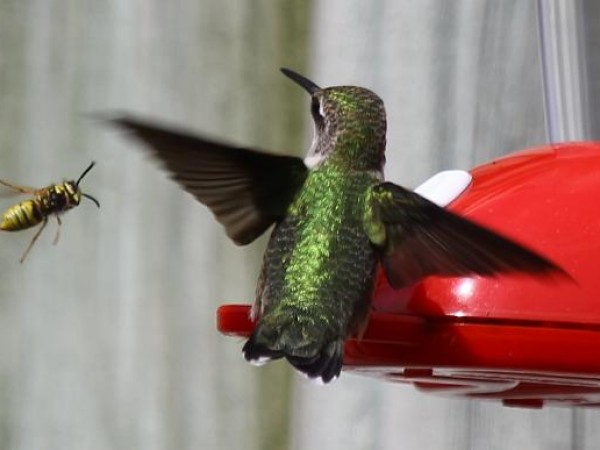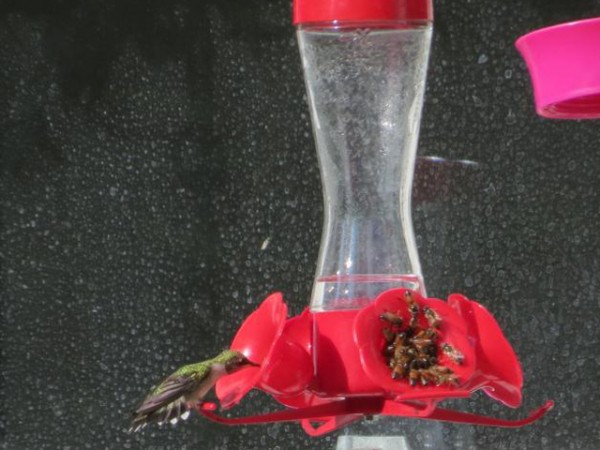Bees At Your Feeders?
Simple, Safe Tips
Introduction
Each fall, people are concerned about bees and wasps competing with hummingbirds at feeders. While some hummers feed in harmony with these insects, many end up fighting hornets, honeybees, and yellow jackets. The most common are bees, wasps, and ants. Other insects such as moths and earwigs may also be attracted to nectar. A feeder with too many bugs becomes contaminated and can keep hummers away. How can you safely discourage pests from bothering feeders so that your visiting hummingbirds will get the sugar-water nectar?
Simple, Safe Tips
Use these simple, safe strategies to keep bees, wasps, and ants away from hummingbird feeders, but still welcomed, as they are valuable to your backyard ecosystem:
- Use caution: NEVER use cooking oil, menthol cough rubs, petroleum jelly or any deterrent that could get on the feathers or in the hummingbirds! This includes any part of the feeder where the feathers or bill could possibly contact the substance. Use commercial insect traps sparingly (and AWAY from the feeder) so you do not disrupt the insects' place in your backyard ecosystem. Never use pesticide chemicals or sprays anywhere near the feeders. Pesticides are poisons! Even a small amount can be devastating to small birds.
- Keep feeders clean: Feeders that leak will attract bees and pests. Frequently clean the outside base and the feeder ports with soapy sponge and lots of rinse water.
- Choose feeders designed to discourage insects: Feeders with saucers position the nectar away from the feeding port where long-tongued hummers can reach nectar, but insects cannot.
- Move the feeder to trick insects: Once hummers find a food source, they will visit it often. Insects are only likely to visit convenient sources and probably won't search for relocated feeders. Moving the feeder by just a few feet can decrease insect visits without discouraging the hummingbirds.
- Give insects their own feeders: Attract the insects by hanging a detour feeder in the full sunlight they prefer and use a sweeter sugar water solution. Place a very shallow bowl with strong sugar water about 5 or 6 feet away from the feeders. (You may need to begin close to the feeder and move it farther away incrementally.) This will keep the insects around to pollinate your flowers while giving them a food source besides the hummingbird feeder.
- Avoid yellow: Red attracts hummingbirds while yellow attracts wasps and bees. Avoid feeders with yellow insect guards or flower accents and your feeder will be less attractive to insects. If you have one with yellow accents, repaint with red, non-toxic paint.
- Use insect traps: Commercial insect traps and feeder accessories are available to minimize insects' access to nectar feeders. While these can be effective deterrents, use them sparingly so you do not disrupt the insects' places in your backyard ecosystem.
- Choose feeder locations carefully: Ants may climb a pole to reach a nectar feeder, so hang the feeder from a branch or gutter instead. Fishing line makes a good hanger; it's hard for ants to climb such a thin line to reach the feeder. Hanging feeders in a shady spot keeps nectar cooler and slows fermentation.
- Keep the yard clean: Remove unintended food sources. The bees, wasps, and ants will be attracted to the area iif they find uncovered trash with sweet leftovers like soda cans.




